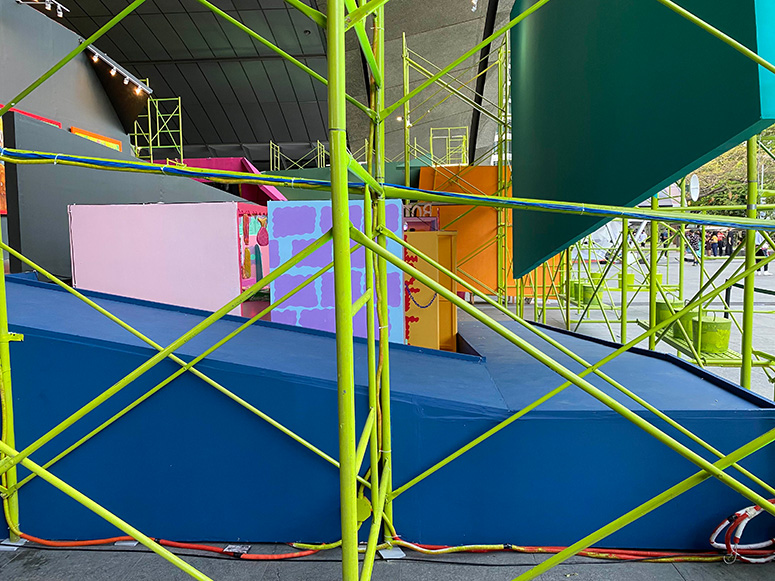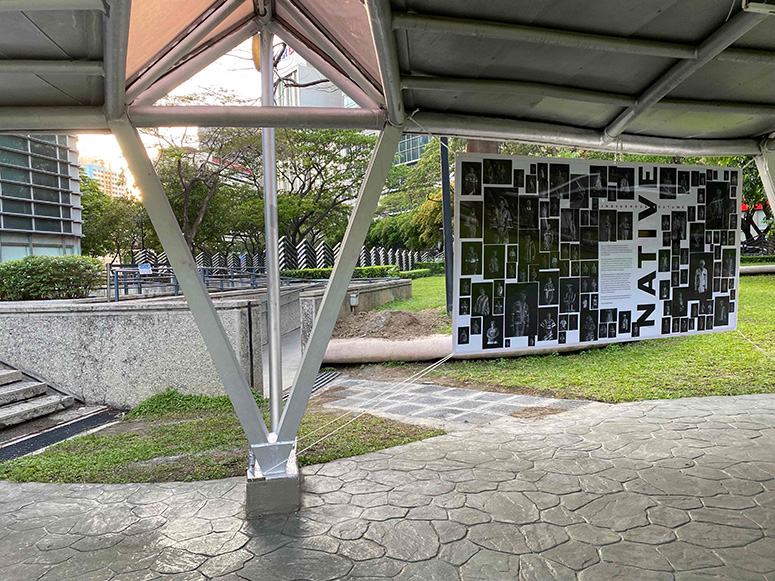What art could learn from parks: Art Fair Philippines & accessibility
In its return to public exhibitions, Art Fair Philippines’ decision to mount its Projects section in the Ayala Triangle Gardens presents a thought-provoking example of design that considers inclusivity for people with mobility and physical disabilities.
The architecture that houses contemporary art in the Philippines at present has a long way to go in terms of accessibility, and it’s not often discussed how exhibition spaces often favor the able-bodied.
Plenty of museums and galleries still have narrow stairs, relatively cramped placement of objects, and no elevators or ramps in sight. When the mobility of PWDs is overlooked, it limits the reach of arts and culture.
The Ayala Park hosted sites for Art Fair Philippines’ Photo, Film, Residencies and AR Art Trail, while exhibitions also took place in participating galleries across Metro Manila. The Projects section, which was mounted in an on-site constructed technicolor hive that is a characteristic of curator Norman Crisologo’s approach, providing a kaleidoscopic maze for the works of participating artists Aro Soriano, Nune Alvarado, Melvin Guirhem, Aze Ong, Bjorn Calleja, Doktor Karayom, Johanna Helmuth, Ryan Jara, Tyang Karyel, and Wyndelle Remonde.
Mounted as well were the culminating exhibitions of Art Fair’s 2021 residences featuring Alwin Reamillo, Derek Tumala, Hannah Nantes, Jao San Pedro and Faye Abantao. The show as a whole was housed under the large amphitheater in front of the entrance to the Philippine Stock Exchange, with a public transport stop nearby.

Within the Projects’ exhibition space, there were wheelchair ramps leading up to the elevated sections of the exhibition, while there was also ample space to navigate. Along the Photo exhibition “Tattoos, Ternos and Couture: A Celebration of Philippine Fashion Photography” that lined the perimeter of the park, there were plenty of ramps and rails.
The whole experience also used the ample ratio of wide paved paths running through the grassy areas between the visual art exhibitions and the Film section as well.

Comparisons to the past Art Fair iterations in the Link are certainly inevitable, because the majority of its attendees were present deliberately. Past the entrance fees and queues, there were rarely any passersby — which has actually been a recurring point of critique about Art Fair in the past.
Though this year’s decision was made on the basis of COVID-19 safety and practicality, rightfully choosing the outdoors over the indoors, the resulting experience is remarkably different.
Aside from the late David Medalla’s captivating presence at “A Stitch in Time” in 2019, where he sat between billowing pillars of cloth surrounded by attendees, a person in a wheelchair was a rare sight. There were also few seats in proportion to the volume of people walking around the multi-floor fair.
In the open-air park, people had plenty of room to sit and relax. The fresh air was a welcome setting for reflecting on how to situate art in the world at large, amidst the pedestrians, joggers and collared finance professionals, traversing through the same space, whether for work or recreation.
Of course, accessibility would also look different within the contexts of museums and galleries as well, depending on the curatorial intentions. Either way, accessibility is an ongoing project that is always worth pursuing.
I should say that, as an able-bodied person, I’m certainly not in a position to speak for the PWD community. However, while walking around the Art Fair and the park, amidst the joggers and the elders, Art Fair Projects’ exhibition design provides food for thought about how it may have imbibed the contemporary approach to park design in which accessibility features are a basic feature.
Conversely, I’m also concerned about how the art itself will hold up in the open air of the Philippine climate — with its volatile elements of wind, rain and humidity, among others. After all, outdoor conditions cannot be controlled as precisely as in an indoor setting.
Allow me a slight tangent to another definition of accessibility, which is more commonly discussed in contemporary art in terms of the Philippine arts ecology: I do miss the Incubators section which was introduced in Art Fair 2019, which shone a spotlight on artist-run spaces and initiatives such as Load na Dito, Project 20, and the all-Visayan show “Giatay.” Accessibility does not progress on a linear track; it expands across many lateral efforts by practitioners across different sectors both within and outside the arts ecology.
Certainly, the aforementioned accessibility features are not the end of the conversation about inclusivity. Within the PWD community are a myriad of experiences and circumstances that, in fact, can and should be approached on a case-to-case basis. Spaces could provide braille guides, audio descriptions for the sight-impaired, sign language interpretation, and so much more.
Of course, accessibility would also look different within the contexts of museums and galleries as well, depending on the curatorial intentions. Either way, accessibility is an ongoing project that is always worth pursuing.
Spaces should have little excuse for overlooking inclusivity, even if rent is high or the literal available space is scarce. After all, the past two years have demonstrated that, whether or not physical exhibitions take place, the art market in the Philippines is still alive and kicking — yes, even against the odds of skyrocketing national debt and inflation.
Next time you visit an exhibition, or any other public space, really, try to observe who or what these architectural and curatorial decisions include or exclude. And consider accessibility as not an option, but a necessity and advantage that could perhaps better serve the public.


